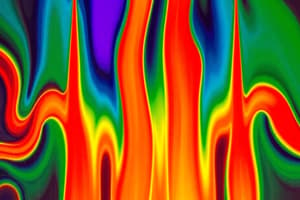Podcast
Questions and Answers
What is the unit of measurement for heat transfer?
What is the unit of measurement for heat transfer?
- calories per minute (cal/min)
- watts per meter (W/m)
- joules per second (J/s)
- joules per kilogram (J/kg) (correct)
Which law describes the rate of heat transfer through conduction?
Which law describes the rate of heat transfer through conduction?
- Newton's Law of Cooling
- Stefan's Law of Radiation
- Ohm's Law of Electrical Conduction
- Fourier's Law of Heat Conduction (correct)
What is the purpose of a heat exchanger?
What is the purpose of a heat exchanger?
- To increase heat transfer (correct)
- To change the state of a substance
- To reduce heat transfer
- To maintain a constant temperature
What is the main function of thermal insulation?
What is the main function of thermal insulation?
What is the purpose of refrigeration and air conditioning systems?
What is the purpose of refrigeration and air conditioning systems?
What is the primary mechanism of heat transfer in conduction?
What is the primary mechanism of heat transfer in conduction?
Which mode of heat transfer does not require a medium?
Which mode of heat transfer does not require a medium?
What is the unit of measurement for heat capacity?
What is the unit of measurement for heat capacity?
What is the term for the energy required to change the state of a substance?
What is the term for the energy required to change the state of a substance?
What is the term for the heat capacity of a substance per unit mass?
What is the term for the heat capacity of a substance per unit mass?
Flashcards are hidden until you start studying
Study Notes
Modes of Heat Transfer
- Conduction: transfer of heat between objects in physical contact
- Occurs due to vibration of particles
- More efficient in solids than liquids or gases
- Convection: transfer of heat through movement of fluids
- Occurs due to difference in density between hot and cold fluids
- Can be natural (e.g. hot air rising) or forced (e.g. using fans)
- Radiation: transfer of heat through electromagnetic waves
- Occurs in all directions, not requiring a medium
- Can travel through vacuum
Heat Transfer Mechanisms
- Heat Capacity: amount of heat energy required to change the temperature of an object
- Measured in joules per kilogram per degree Celsius (J/kg°C)
- Specific Heat Capacity: heat capacity of a substance per unit mass
- Measured in joules per kilogram per degree Celsius (J/kg°C)
- Latent Heat: energy required to change the state of a substance (e.g. melting or boiling)
- Measured in joules per kilogram (J/kg)
Heat Transfer Equations
- Fourier's Law of Heat Conduction: rate of heat transfer through conduction
- Q = -k * A * (dT/dx)
- Q: heat transfer rate, k: thermal conductivity, A: cross-sectional area, dT/dx: temperature gradient
- Newton's Law of Cooling: rate of heat transfer through convection and radiation
- Q = h * A * (T_s - T_e)
- Q: heat transfer rate, h: heat transfer coefficient, A: surface area, T_s: surface temperature, T_e: environment temperature
Applications of Heat Transfer
- Heat Exchangers: devices that facilitate heat transfer between fluids
- Examples: radiators, heat sinks, and boilers
- Thermal Insulation: materials that reduce heat transfer
- Examples: fiberglass, foam, and reflective insulation
- Refrigeration and Air Conditioning: systems that use heat transfer to cool or heat spaces
- Examples: refrigerators, air conditioners, and heat pumps
Studying That Suits You
Use AI to generate personalized quizzes and flashcards to suit your learning preferences.




